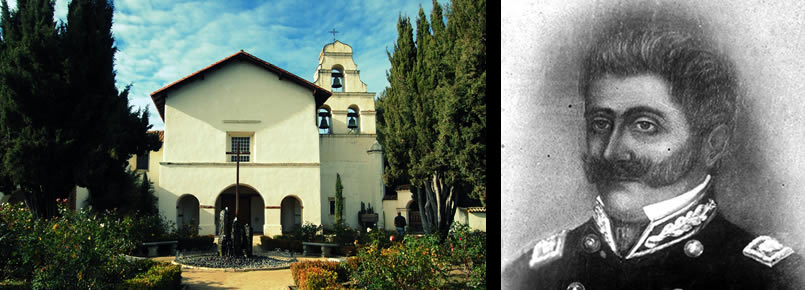

American Latino Heritage
Gonzalez House
Santa Barbara, California
 |
The Gonzalez House in Santa Barbara, California - |
By the late 1700s and early 1800s, Spain extended its New World Empire by colonizing the west coast of North America. The Spanish created permanent settlements in Alta California by constructing presidios (forts) and establishing missions throughout the region. Founded on April 21, 1782, the Santa Barbara Royal Presidio was the last in the chain of Spain’s four military fortresses built along the Alta California coast. Other presidios were already in place at San Diego, San Francisco, and Monterey.
Presidios provided settlers and missions with protection, served as military headquarters and governmental centers, and guarded Spanish settlements from foreign invasion. As with other presidios throughout Alta California, local Chumash Indians under the supervision of Spanish soldiers constructed the Santa Barbara Royal Presidio’s buildings. They used sun-dried adobe bricks for the buildings and covered finished walls with whitewash. Laid out around a central parade ground, the presidio had a large outer defense wall that surrounded all of the buildings. Today, El Presidio de Santa Barbara State Historic Park preserves this original Spanish military outpost.
Following the establishment of the presidio, the Spanish founded the Santa Barbara Mission in 1786 as the 10th mission in Alta California’s 21-mission chain. The mission expanded with the construction of three adobe churches on the grounds, each larger than the one before it. The fourth church that dates from 1820 still stands today. The church is of local sandstone with heavy exterior buttresses for support. Today, visitors are welcome to tour the Santa Barbara Mission, which is also featured in this itinerary.
 |
Santa Barbara Mission c.1916 |
The presidio and the mission played important roles in Rafael Gonzalez’s life, as they did in the lives of many of the settlers in and around the Spanish settlements in Alta California. On February 20, 1797, Gonzalez was baptized at the Santa Barbara Mission, and in 1816, he enlisted as a soldier in the garrison at the Santa Barbara Royal Presidio. For the next 11 years, Gonzalez participated in many military assignments and witnessed attacks and revolts. His first assignment was in 1817 at Mission Santa Ines (also included in this itinerary), where he was part of the mission guard.
By 1818, Gonzalez was back at the Santa Barbara Royal Presidio when the Argentinean explorer and privateer, Hipolyte Bouchard, invaded the California coast at Monterey. Gonzalez was sent, along with Sergeant Anastasio Carillo and a small group of cavalrymen, to provide support during this attack. They were too late to protect Monterey, because Bouchard had already sacked and burned the city.
Following Bouchard’s attack on California, Gonzalez witnessed two mission revolts-one at the Mission San Buenaventura and the other at the La Purisima Mission. The revolts resulted from years of rising tension between soldiers, mission people, and Indian neophytes (converts). By 1811, due to the Hidalgo Rebellion in New Spain that began Mexico’s war for independence from Spain, supplies and money stopped coming to the California missions from New Spain (Mexico). In addition, Spanish governors would not allow the missions to trade with foreign merchants. All of this led to supply shortages, and the tension grew among everyone involved with the presidios and the missions. The soldiers often took out their frustration on the Indian converts. By the early 1820s, the tension reached a breaking point and the Indians revolted. The soldiers regained control of the missions but the missions would never fully recover.
In 1825, Gonzalez became the corporal of the guard at Santa Ines, and in 1827 received his discharge from the army. Soon after his discharge, Gonzalez returned to Santa Barbara and served as the alcalde (mayor) in his hometown in 1829. Santa Barbara and California were by then a part of Mexico, which gained independence from Spain in 1821. During this Mexican period of California’s history, Gonzalez built a medium-sized adobe home with two to three foot thick walls for his Italian wife.
 |
View of the library in Randall House Rare Books, |
Constructed around 1825, the home has seven rooms, two-one room wings that project off the main portion of the house, covered verandas, and a tile roof. Gonzalez built the adobe on acreage the King of Spain had deeded to his family known as “Las Isletas.” The “Las Isletas” were small areas of high ground surrounded by the swamps of a local lagoon. The street still bears the name, “Laguna Street,” because of this lagoon.
The Gonzalez House is a classic example of a medium sized Mexican-era adobe town house built during California’s Mexican period, and therefore, provides visitors with a glimpse into history and the style of homes that people resided in while living in the Santa Barbara area over 150 years ago.
Eventually, Gonzalez deeded the house to his daughter, Salome Francisca Ventura Ramirez. She lived in the house with her husband Cristobal Ramirez from March 17, 1866 until her death in 1923. By the mid 1900s, Louise Murphy Vhay and David Vhay, a couple interested in the architectural styles of New Spain and Mexico restored and enlarged the house.
Today, the Gonzalez House is the home of a bookstore, the Randall House Rare Books & Fine Art shop. The store is open to the public and welcomes visitors to come explore the Spanish and Mexican heritage reflected in this historic adobe.
| Plan your visit |
| The Gonzalez House, a National Historic Landmark, is located at 835 Laguna St. in Santa Barbara, CA. Click here for the National Historic Landmark file: text and photos. The Randall House Rare Books & Fine Art shop located in the Gonzalez House is open 10:00am to 5:00pm Monday through Friday and 10:00am to 2:00pm on Saturdays. For more information, visit the Randall House Rare Books & Fine Art website or call 805-963-1909. |